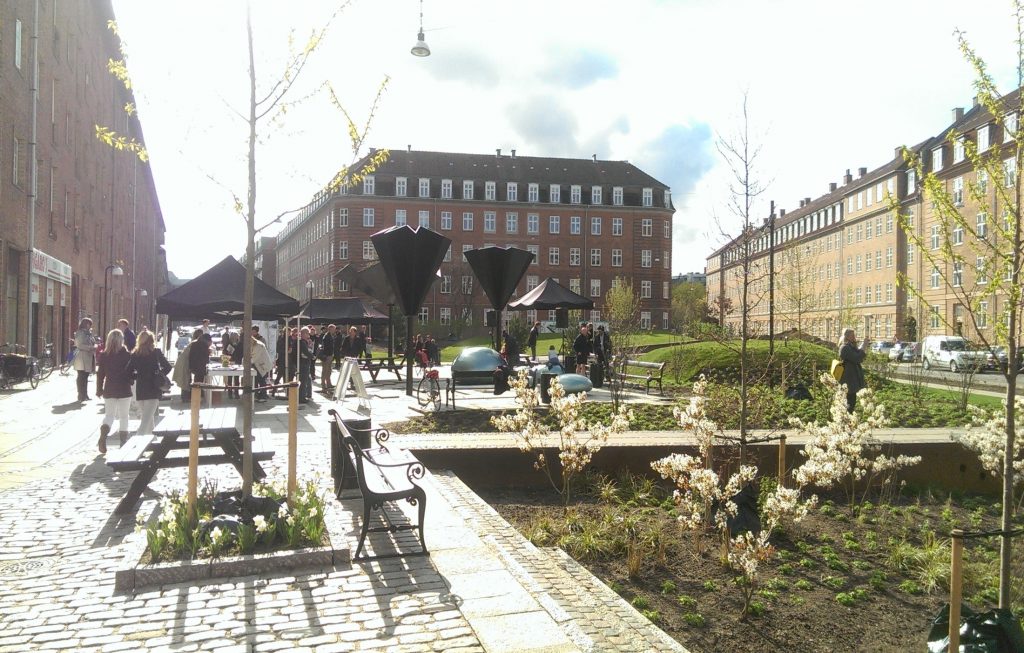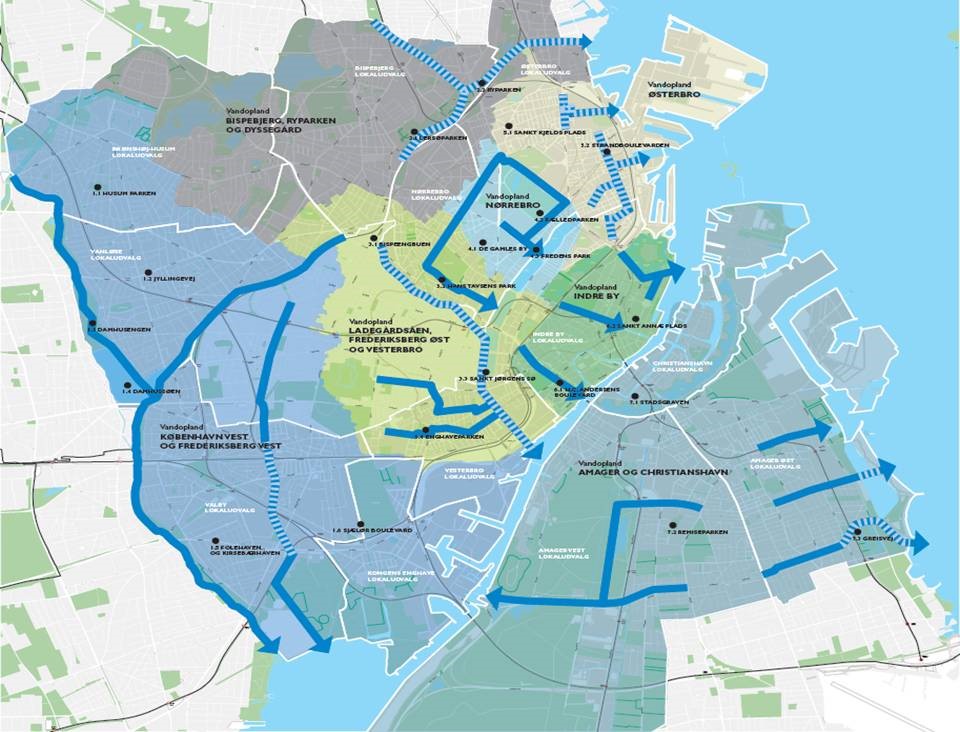Preparing for the “New Normal”
Adjusting to climate challenges with smart design
Copenhagen is a northern harbour city which has experienced a number of severe rainfall events, namely cloudbursts, with the largest pouring down in July 2011. The damages amounted to around 1 billion US dollars, and climate projections predict even larger events in the future. Protecting citizens and businesses from the impacts of climate change, while also continuing to secure high quality drinking water for a growing population are the concerns related to water.
Copenhagen is addressing impacts from climate change through their Climate Adaptation Plan and a new Cloudburst Management Plan (CMP) launched in 2011, which is the world’s first city wide plan for controlled storm water for a 100-year storm. The plan has been developed in a close partnership the Greater Copenhagen Utility, owned by a number of municipalities in the Greater Copenhagen Region. The CMP proposes infrastructure levels to manage storm water in the city, with solutions that collect, delay and lead stormwater to final outlets in the harbour, preventing entry in the sewers. Copenhagen is taking strides to waterproof their city, with demonstration areas and co-creation with local stakeholders.
Smart and resilient urban growth
The capital of Denmark is a relatively small city – but it is a city that has a worldwide impact due to creative solutions and the constant aim to improve the quality of life for citizens.
Copenhagen is growing with 600.000 inhabitants and an expected growth of 100.000 more before 2025. This is a challenge as the city has to use all available land for building new homes in an area of around 10 square kilometres. The growing population is also a challenge to create affordable housing for the entire population.
“Because we are growing we have to look at different ways of densifying the city – using old industrial spaces, but also building, higher, closer – and this is a challenge when we are also facing climate changes” Lykke Leonardsen, Program Manager Green urban solutions, Municipal Development.
The water challenges are about continuing to secure high quality drinking water for a growing population, while also protecting the citizens and businesses from the impacts of climate change, such as from cloudbursts. HOFOR, the Greater Copenhagen utility, is working to secure and protect future water resources for its customers in collaboration with neighbouring municipalities. They are doing so by implementing the Cloudburst Management Plan and by, for example, planting trees that can help the infiltration period and can also reduce the use of chemical substance in receiving waters
The Vision for the Future
Working across sectors, Copenhagen is setting ambitious goals for the future. The city just approved a new vision called Co-Create Copenhagen, with three key pillars: A liveable city, a responsible city, and a city with an edge; enabling strong citizen participation along the journey.
The city’s vision for liveability is a key factor in implementation. The CMP will form the back-bone of the physical development of the city for the next 20 years and it emphasizes the role of citizens in the co-creation of their future city. This includes involving the citizens in the understanding of the new concept of stormwater management through the CMP – and how this has added benefits even when it is not raining.
Copenhagen Climate Adaptation Plan from INDEX: Design to Improve Life® on Vimeo.
Case Study: Skt Kjelds - A Climate Neighbourhood
As part of the implementation of the CMP, the city selected Skt. Kjelds as demonstration neighbourhood, where some of the first projects are being implemented. This includes the first water park at Tåsinge Plads and tunnels for stormwater discharge into the harbour. The development involves local stakeholders in the design and function of the projects, including refurbishment of the buildings, courtyards and open spaces.
4 Levels of Action - Copenhagen’s Progress Towards the Principles
Regenerative Water Services
• The City and HOFOR are working on improving the ground water by careful monitoring of infiltration. Copenhagen Municipality’s water supply comes from wells outside the metropolitan area, adjacent municipalities draw from the aquifers below the city.
• The City has strict regulations on the discharge of pollutants into water bodies – whether it is the harbour or fresh water bodies. This is regulated in the water action plan which also aims to further reduce combined sewer overflows mainly into some of the fresh water bodies.
• Copenhagen has been working on reducing water consumption for a number of years – the goal is to reach 100 litres per citizen per day.
• The city has a goal to become carbon neutral by 2025 – this also applies for the utilities.
• Storm water can be used for watering – and over time also reused in households
• Copenhagen has the goal of becoming carbon neutral – and that also includes the utilities that are working on a carbon neutral water supply and waste water management.
• The HOFOR cloudburst management plan is using different approaches to manage large amounts of stormwater through local storage, infiltration and discharge through a new parallel system.
Water Sensitive Urban Design
• The Cloudburst Management Plan
• Designing urban spaces to reduce flood risks is a key element of the Cloudburst Management Plan
• Enhancing liveability with visible water is also an integral part of the Cloudburst Management Plan
• Copenhagen’s municipality no longer uses pesticides in the maintenance of public areas
Basin Connected Cities
• HOFOR - Copenhagen secures its future water resources - abstracted from wells outside the city - in collaboration with neighbouring municipalities. The focus is mainly on protecting the water quality.
• HOFOR are protecting the quality by, for example, planting trees that can help the infiltration period and can also reduce the use of chemical substance in receiving waters.
• Climate Change Adaptation Plan- looks at the challenges from rising sea levels, cloudbursts, extreme heat, etc.
Water-Wise Communities
• The work on the Cloudburst Management Plan involves citizens in the understanding of the new concept of storm water management – and how this has added benefits when it is not raining.
• Interdisciplinary work led to integrating the city’s urban nature strategy with the cloudburst plan (professionals from NGO’s, universities and urban planners developed the principles of eco systems services and adaptation in the city).
• Engineers, urban planners, biologists, economists and more are involved in the adaptation planning of the City.
• Change in national legislation to enable financing the new and innovative solutions.
• Strong political leadership by the Mayor and its administration.
Blog posts
Latest opinions and insights relevant to the water sector




